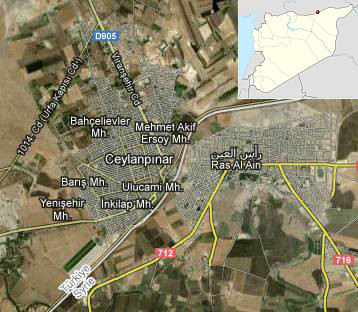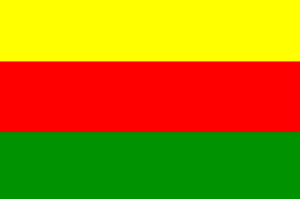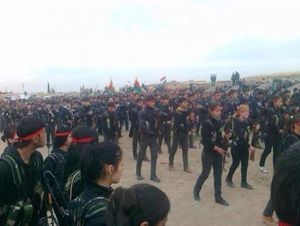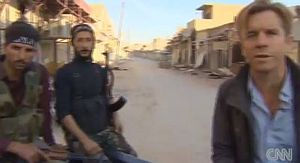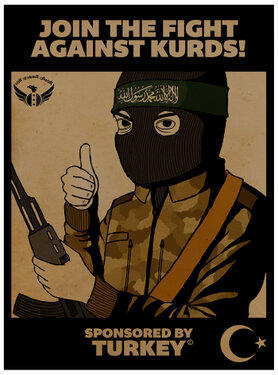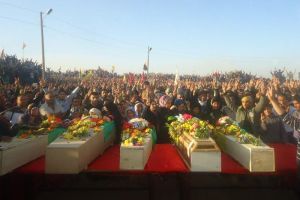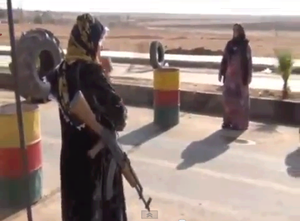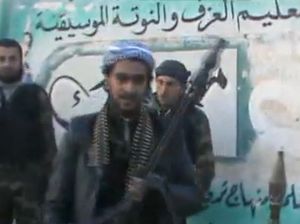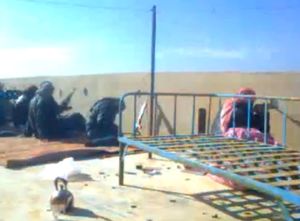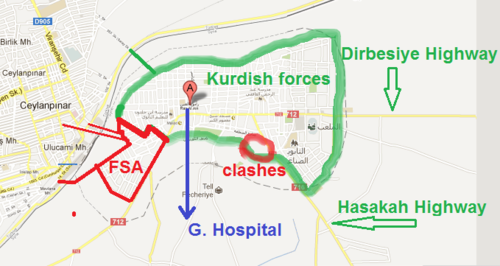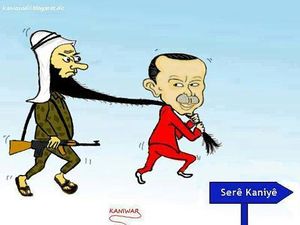Assault on Ras Al-Ayn
Ra's al-'Ayn (Arabic: رأس العين, Kurdish: Serê Kaniyê) is a Syrian city administratively belonging to Al-Hasakah Governorate. It had a population of about 50 thousand, mostly consisting of Assyrian/Syriacs, Arabs, Kurds and Armenians.
Together with its Turkish twin city Ceylanpınar (predominantly Kurdish population of formerly around 45 thousand, also called Serê Kaniyê in Kurdish) it's divided by the Turkish-Syrian border since after the Franco-Turkish war following the Ankara Agreement in 1921. The Baghdad Railway runs along the border which is guarded exclusively by the Turkish Army following the so-called Adana agreement from 1998.[1]
As of January 2013, Ceylanpınar hosts one of the largest refugee camps on Turkish soil with over 35 thousand inhabitants mostly coming from Ras Al-Ayn due to the events covered in this article.[2]
Who's fighting?
While the Free Syrian Army (FSA) will be known to most readers, the forces of the other side and the general situation may require a short introduction to illustrate the significance of the conflict.
The Democratic Union Party (PYD) is the largest single Kurdish party in Syria and is ideologically affiliated with the Turkish PKK (Kurdistan Worker's Party), which is labeled as terrorist organization by basically anybody who wants to do business with Turkey. Both share the ideology of Abdullah Öcalan, which is aside from Kurdish nationalism a form of non-hierarchical self-organization through committees, but the PYD denies sharing the violent methods of the PKK and having direct ties to them. There are a number of other Kurdish political organizations of different ideologies in Syria, some of which are organized in the Kurdish National Council (KNC) formed in 2011. KNC forces have accused the PYD of collaboration with the Assad government, while the PYD denies the accusation and says they are part of the revolution, like the KNC.
In July 2012, PYD and KNC together formed the Kurdish Supreme Committee (KSC) as interim governing body of the Kurdish dominated Syrian territories, which they call Western Kurdistan (Kurdish: Rojava), and the Popular Protection Units (YPG) as armed wing of that governing body. While in other parts of Syria army defectors have joined the FSA, Kurdish soldiers are more likely to have joined the YPG, although its bulk consists of local militias. According to PYD leader Salih Muslim, the YPG has around 10,000 men and women under arms. There have been reports about a deal between Kurdish forces and Assad government about more autonomy in the region parallel to the formation of KSC and YPG, but Salih Muslim denies any kind of deal.[3]
However, by start of the events in November 2012, most but not all Syrian Arab Army forces have left the region.
As should be known by now, there are many different fractions who operate under the banner of FSA, and what is called FSA especially in the beginning of this article is not operating on behalf of what comes closest to an FSA leadership, at least according to the latter.
- Additional remark from July 2014: There has been a seamless transition from forces using the "FSA" label talked about in the beginning of this article, over Jabhat Al-Nusra and other more openly Islamist forces mentioned later, to fighters belonging to ISIS who in the summer of 2014 started an Assault on Kobane which quite exactly mirrors the events discussed here.
Summary of events
On February 1, 2013, Syrian Kurds in the UK delivered a letter on behalf of the KSC to Foreign Minister William Hague. It's reproduced here in full because it contains a brief summary of the events covered in detail below.[4]
Dear Mr William Hague,
We, the representatives of the People's Council of Western Kurdistan and the Kurdish National Council in the Uk, would like to draw your attention to the recent attack on civilians in Sere Kaniye (Ras al Ain). Armed Selafist groups entered the region from Turkey supported and facilitated by the Turkish military and regional powers with the aim of destabilising the relatively peaceful region and dragging it into a violent sectarian war. Since the second attack began on 16 January 2013 armed mercenaries have been using heavy weapons to shell the city killing civilians indiscriminately, many civilian Kurds have been taken as hostages and their houses and properties have been destroyed or looted. Thousands of vulnerable women and children have become displaced through fleeing from the horror.
Since July 2012 the Syrian Kurds have been managing and governing themselves and their region democratically and peacefully. They actively contribute in building a democratic, plural and united Syria where all Syrians can enjoy living together freely and thus regional stability, democracy and peaceful co-existence.
We earnestly call on the UK government and its Foreign Ministry to put pressure on the NATO allied Turkish government to end its foreign intervention by supporting those terrorist affiliated groups that are destabilising the Syrian Kurdish region.
We also ask that the UK's Foreign Minister to persuade the Syrian opposition to end supporting those armed groups and demand their withdrawal from the peaceful Kurdish region and so respect the legitimate Kurdish national rights.
Thank you for your kind attention and we look forward to your assessment.
Yours Sincerely,
Representatives of:
Kurdish National Council , People's Council of western Kurdistan in the UK.Chronology of events
November 8-11: FSA comes to town
According to Kurdish sources, on November 8, 2012 at 4 am several hundred FSA fighters entered the town from across the Turkish border, from where they went into Arab dominated parts of the city. Clashes with the few remaining soldiers of the Syrian Arab Army took place. The injured FSA fighters were carried back across the border to hospitals in the Turkish twin city Ceylanpınar.[5]

This can be seen on videos uploaded to youtube. The border crossing is labeled on wikimapia, where somebody took care of good orientation, as "occupied". Injured fighters coming back to Turkey under the watchful eyes of Turkish soldiers seen here dated Nov 12, captured "Shabiha" among celebrating FSA fighters brought across the border at the same place dated a day earlier, interviewed Islamist fighters with Al-Jazeera again at the crossing, Nov 9, etc. Just some examples from a large video collection.[7]
The Kurdish Supreme Committee (KSC) issued a statement requesting the fighters to leave town, to avoid giving the Syrian Army a pretext to attack the city, and urging all parties to stay united and not give way to sectarianism. One fighter of the KSC's armed wing, the Popular Protection Units (YPG), was killed in the crossfire. [5]
In the following days the FSA took over police and other official buildings and clashes between them and the residents occurred. For example youths were stopped trying to raise a Kurdish flag, while FSA fighters were seen raising Turkish flags.[8]
An eyewitness account of a "young Christian of the opposition" published by Vatican News Agency Fides end of November reports harsh sectarian assaults on minorities:
- "In the middle of the night, at two on 8 November, residents of Ras al-Ain were awakened by the sound of explosions, of helicopters and machine guns. They were the fighters of the Free Army and Turkish helicopters reached Syrian territory and easily conquered the border crossing and the city. The military began to seize civilian homes to use them as fighting positions. My grandfather’s home was among those that were seized, where there were women, children and paralyzed grandmother. All Civilians were Expelled from their homes in pajamas, without being able to take documents, money or anything else. Military and combatants went further: with a 'black list', they went from one house to another looking for their enemies. [...] In Ras al-Ain, the victims were not only Christians, but Christians were the only ones who were immediately expelled from their homes, carrying babies in their arms, put to flight the streets strewn with corpses. [...] Kurds, Arabs and Christians, more than 70.000 people fled, mostly to Hassake. Within hours, the city became a ghost town. The Alawites had the worst destiny: killed because Alawites. [...] We have always accused the regime of these disasters. Now we talk about the crimes that we have seen with our eyes, perpetrated by the Free Syrian Army."[9]
November 12-14: Syrian Army responds
Also clashes with reinforced troops of the Syrian Arab Army took place and starting November 12, they targeted FSA-held positions from air, with considerable collateral damage. Kurdish sources report 8 dead and 57 wounded in the bombing of the districts Mehet and Tel Xelef on the 12th[10][11] These reports mention that parts of the fighters belong to the Al-Nusra Front and that the usually closed border was cleaned from landmines before the FSA troops crossed it.
On the 14th, the Army went over to targeting surrounding villages to which the FSA troops had apparently fled [12] after they were chased out of the city center. Also on the 14th, the Kurdish sources report that 600 additional FSA fighters arrived near the Turkish side of the city, where they were transported to in civilian cars from Hatay Province coordinated by Turkish Intelligence (MIT).[13]
November 15-18: Silence ... for the moment
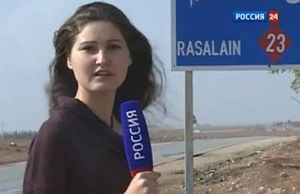
If those fighters did reach Ras Al-Ayn is unclear (reports from other parts of the border region suggest that they could have been headed elsewhere), but it seems like some kind of ceasefire ensued for the moment, as on the 15th the KSC sent a delegation to take a look at the destruction and urge the by now 11500 refugees to return.[15] According to Firat News Agency, in total at least ten civilians were killed and 70 wounded, with around 50 houses destroyed.[16]
Also a team from Russian vesti.ru TV reported from the town, published a day later.[14] While their footage, allegedly showing Yemeni and Saudi fighters inside the town, seems to be mostly not filmed by them (for example they show excerpts of a video showing brutal door-to-door raids available on youtube since at least two days before[17]), they are seen at a road leading to Ras Al-Ayn and interviewing refugees and a Kurdish fighter outside of town. As a female refugee states:
- All are shooting there, the ones that have a black flag, the others have a Kurdish. There are bombs. We are afraid for our children, we want peace, and we are waiting here now till Turkish border guards fetch us.
Also on the 16th, CNN broadcasted a report with their unavoidable war reporter Ivan Watson who obviously had crossed the Turkish border together with the Islamist fighters and shows the viewers around, meeting "random" citizens standing on Assad pictures. He reports the warning the local councils had given to his companions, that not only the Syrian Army but also they are not welcome in town.[18]
Published on the 15th, the infamous Farouk Brigade of FSA is seen in a longer video showing them "capturing a Syrian Army checkpoint" in Ras Al-Ayn. A lot of ammunition and men, but no fighting, are seen.[19]
November 19: More FSA against the YPG
On the 19th, the KSC had called for a demonstration against the besiege by the remaining Islamist forces under the motto "Return to the homeland". Kurdish sources report that in the morning the Islamist groups "El Şam, Ehfad El Resul and Cebet El", reinforced across the border by newly arrived fighters "belonging to Graba al Sham and Nasra", maybe the 600 men mentioned days before, started to erect road blocks and attacked the arriving civilian protesters. The head of the local people's council Abid Xelil, who tried to negotiate with them, and a youth were killed. Following this, heavy clashes started with forces of the YPG who had come from the whole region following the call of the KSC to defend the town.[20][21]
November 20: Enter Turkish Army
These clashes between FSA and YPG lasted until late into the night and were accompanied by the Turkish Army firing short-range missiles across the border into the city, giving protection to the FSA by targeting YPG forces. In a press release, a German-Kurdish organization states (translated):
- Turkey has taken a definitive position during the events. While Turkish territory was at no time under military threat, the Turkish Army actively intervened in the fight. It's also striking that the attacking forces were able to cross the Turkish border without problems and the landmines, which were placed at the border strip for 30 years, were removed by Turkey just in time.[21]
A press release of the YPG on Nov 20 describes the outcome of the fights: With four YPG fighters dead, the attacking forces were beaten and 18 corpses handed over to them, among them group leaders, with seven fighters arrested and weapons and equipment confiscated. An unknown number of dead and injured fighters were brought across the Turkish border into Ceylanpınar together with the withdrawing forces. The YPG demanded from the FSA command to distance themselves from "these groups controlled by Turkey". The statement ends with a call to the youths of the region to join the YPG to defend against further assaults.[22]
Later on Nov 20, official FSA commander Riad Al-Asaad indeed gave a statement to the website Welati declaring that the group Ghurba' al-Sham has no official links to the FSA and that "there are some groups trying to exploit the situation in order to blow up relations between Kurds and Arabs."[23] Abdulbasit Sieda, until recently head of the SNC and a Kurd, blamed Jabhat al-Nusra for the events and called the attacks on civilians "unacceptable" in an interview the week before.[24]
The Erdogan-friendly Turkish Daily Today's Zaman reports the events of the day relying on the Syrian Observatory for Human Rights (SOHR) in a generally similar fashion with regards to clashing parties and death toll of the Kurdish side, although with no mentioning of the death toll of the other side, where the "Syrian opposition forces" were coming from and of the Turkish Army playing an active role firing missiles across the border:
- On Monday, gunfire clattered in the mixed Arab and Kurdish frontier town of Ras al-Ain, which was overrun by the mainly Sunni Muslim Arab opposition on Nov. 8 and bombed by Assad's forces in the days that followed. [...] With its own large Kurdish minority, Turkey is watching closely, worried that the emergence of an autonomous Kurdish region in Syria could further embolden militants of the Kurdistan Workers Party (PKK) fighting for autonomy in southeastern Turkey.[25]
November 21-22: Return after withdrawal ... with tanks
On Nov 21 after the withdrawal of the attacking forces to Turkey, the burial of the four Kurdish fighters Khaled Omar Hamou, Sala Ayo Sexo, Suleyman Sino and Ahmed Kawas and the council leader Abid Xelil took place with thousands of attendees.[26]
According to Kurdish sources, the same day the Islamist attackers returned across the border with 50 military vehicles, among them seven tanks. Word is that the vehicles were captured in the Aleppo region and made their way north-east through Turkey.[27]
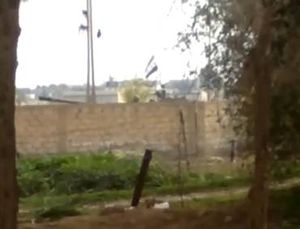
After heavy fighting with the YPG the attackers again withdrew behind Turkish borders, just to return for another attempt on Thursday around 2 pm. According to the SOHR the fighters consist of 200 men of the Al-Qaeda-affiliated Al-Nusra Front and 100 men of Ghurba' al-Sham.[28] The Islamist character of those groups is also indicated by a surfaced video which shows a certain Sheikh Abdel Tawab with an uncanny optical resemblance to the late Bin Laden giving motivational support and praising Jihad to fighters in Ras Al-Ayn on Nov 21. It's unclear if this congregation happened on the Turkish or Syrian side of the border.[29] The Sheikh has been seen at a Syrian opposition conference in Istanbul on March 27, 2012.
The YPG meanwhile formed a new Brigade named "Martyr Abid" after the killed city council leader Xelil and is reported to fight with 400 men against the Islamist attackers.[30]
In a statement released on Nov 22, the Kurdistan Communities Union (KCK) Executive Council Presidency said that the Turkish state is enabling the passage of these groups through their territory. They called on Kurdish people in Turkey to "take to the streets to close the border in Antep-Urfa-Mardin region to prevent the passage of paramilitary forces". KCK added that Turkey is trying to "turn the war in Syria to a war between Kurds and Arabs". In an interview with Kurdish Ronahi TV the day before, YPG commander Sipan Hamo alleged that the events are part of a Turkish plan to occupy "West Kurdistan".[31]
Asked in an interview the week before if such a plan exists, SNC's Abdulbasit Sieda denied any knowledge and called it unlikely.[24]
In the fightings on Nov 22 at least 25 attackers died and 24 were wounded, apparently with only one dead among the YPG fighters. A video shows the city - allegedly all of it - under YPG control.[32]
November 23-25: Truce
After the attackers were again beaten in attempts to conquer districts Hawarna and Xiraba on the morning of Nov 23, they asked the YPG for a truce, which was granted for an initial two days, under the conditions that Ghuraba al Sham will completely leave the town and a new city council consisting of Kurds, Arabs, Armenians and Assyrians will be formed and accepted as authority. If this will not have happened after the two days, YPG announced they would chase all foreign groups out of town.[33]
Despite the negotiated truce, on Saturday some groups continued their attacks on Ras Al-Ayn. Mentioned are Liwa al Tawhid and Cebel al Zewye[34], while other groups apparently stopped fighting, left already or are in negotiations of prisoner exchanges. [35]
Firat News Agency reports about a press conference held in the Turkish Parliament by BDP party deputy Ertuğrul Kürkçü:
- Kürkçü pointed out that the Turkish government is enabling Al-Qaida, Al-Nusra and FSA (Free Syrian Army) militants to cross Turkey's border despite the lack of any parliament vote on the issue. [...] Kürkçü noted that three thousand Kurds who have fled to the border to take refuge in Turkey because of ongoing clashes are still kept waiting at the border, while health institutions and organizations in Ceylanpınar have mobilized for the treatment of wounded FSA militants. [...] Kürkçü called on the AKP government to take measures for the ending of the activity at the border and added that any kind of gang activity surrounding the state will also make all Turkey’s citizens face the violence of a maverick organization that recognizes no laws.[36]
On November 25, around 100 fighters of FSA-affiliated groups gathered at the border and declared to intend to stop fighting and leave town. Reportedly Turkish proxies tried to persuate them to press on and promised new weapons, but that offer was declined. Turkey subsequently closed the border.[37]
Two months later
As of mid-January 2013, the situation remains more or less the same. A fragile truce between the local fractions, with the YPG playing the main role in defending against repeated new attacks by foreign gangs coming from Turkey.
Clashes include occasional involvement of both Syrian and Turkish planes.[38]
January 16: Back with tanks
In heavy fightings starting around January 16, Kurdish sources report more than 70 foreign fighters killed with minimal losses on the side of the defenders of Ras Al-Ayn. Video shows fighters with tanks approaching the border from the Turkish side.[39]
Based on testimonies of both pro- and anti-Assad activists, AFP reports forces of Jabhat Al-Nusra and other Islamist groups crossing the border from Turkey with three tanks on January 17,[40] while Kurdish sources a day later speak of a total of seven tanks that crossed the border, two of which were destroyed and one captured after they bombed a school in Xidir Dire district and random civilian targets in the afternoon of January 18. The report mentions that local Arab youths joined the Kurdish fighters in the struggle against the foreign attackers.[41]
Other sources aren't that clear about the Islamist character of the attackers and report verbal bickering between FSA and the YPG-affiliated largest Syrian Kurd party Democratic Union Party (PYD) leading up to the reignited fightings:
- In a statement released by the FSA’s Military Council in Hasakah they called the PYD mercenaries of the Assad regime and Kurds their brothers. “Despite all our attempts to avoid bloodshed, they insist on protecting the system (Assad government) and they fight against the FSA on behalf of the system,” the FSA said in the statement. [...] Sheruan Hassan, a representative of the PYD in the Netherlands, told Rudaw that the PYD does not want the FSA or Assad in Kurdish areas. “We don’t want Bashar al-Assad, or any other power. We want to rule ourselves, not someone from Damascus, Homs or others. That time is over.” He said the Kurds do not need radical groups and if they want they can “liberate” other cities such as Homs or Aleppo. “Our cities are sort of freed. We don’t need them (FSA).”[42]
In a statement released by the Kurdish National Council, the FSA is called to "pressure these militants to stop this criminal war which is detrimental to the Syrian revolution."[43]
With apparently still intensifying clashes, on January 20 SOHR speaks of 33 people, 28 of them from the attacking side and 5 among the defenders, killed in the two days before,[43] while Kurdish sources speak of a total of 84 killed attackers, with two dead and four wounded among the YPG, since the border-crossing on January 16 which started the latest part of the ongoing assault on Ras Al-Ayn.[44]
As in November, wounded fighters are brought back over the border where they are treated in the hospital in Ceylanpınar, the Turkish part of Serê Kaniyê.[44] Meanwhile, in what can only be called ironic statements, the Turkish government has criticized the US for "the timing" of their declaration of Jabhat Al-Nusra as a terrorist organization.[45]
In a statement by the "National Coordination Body for Democratic Change in Syria" the attacks and their backing by Turkey are condemned and the groups involved specified "such as":
- The Brigades of Ahrar Al'oma (the free people of the nation), Ahrar Gowairan (free people of Gowairan), Mishaal Tamo, Gorabaa Alsham, the descendants of the Ahfad al-Rasul Brigade, Abna Saad bin Abi Waqas Brigade and troops linked to the military council of the Free Army.[46]
Asked about those links, a FSA representative stated that those groups were "serving foreign agendas" and not acting on behalf of the FSA.[47]
According to the youtube description of the above video (which shows no visible effects of violence on humans), the man seen supervising the group is somehow affiliated or even a member of the SNC (unclear because of auto-translation from Arabic - his name is given in full or in part as Ahmed Hammad Al-Assad Melhem).
On January 21, SOHR reports about killed children and other civilians and calls for a UN investigation into the events
- ... in order to bring all those responsible to justice. We also bring to the UN's attention that they cannot refuse to send a mission by using the Syrian authorities refusal as an excuse, since the regime has no control whatsoever on that part of Syria. It would be easy to enter and leave through the Turkish border, which is controlled and used by the rebel factions.[48]
A day later, Erdogan-friendly Turkish paper Today's Zaman "informs" their readers:
- Authorities shut down schools in a Turkish border town on Tuesday after a resident was hit in the head by a stray bullet fired on Monday during clashes between Syrian opposition fighters and Kurdish militants linked to the terrorist Kurdistan Workers' Party (PKK).[49]
After a week: Battle still raging
After seven days of fighting, on January 23 Kurdish sources report that while the battle is still going on in some districts, 90% of Ras Al-Ayn is again under control of the YPG and some gangs have fled the city giving up a Hospital they had used as a base.[50] Despite this and other success reports, fierce clashes continued during the next days. Kurdish sources report territorial gains and heavy losses among the attackers with "dozens" dead and "many" wounded on January 25[51] and 20 dead and "dozens" wounded on January 26.[52] Among the defenders a killed YPG commander is mentioned on January 26[52] and Firat News Agency reports at least two killed fighters on January 27.[53]
Civilian casualties are not reported beside one seven year old girl wounded from stray bullets on the Turkish side of the border.[54] She can be seen in a short Reuters video being transported via ambulance to Ceylanpınar hospital[55], while raw footage uploaded to youtube shows a long line of wounded, fighting aged, Arabic speaking men transported in and out of the same hospital with Turkish ambulances.[56]
Meanwhile the Turkish military has strengthened its troop presence in Ceylanpınar.[52]
A map published on twitter allegedly shows the areas of control and the points of fighting on January 26:
The same twitter user reports that Ghurabaa Al-Sham announced to bring "all its battalions from all over Syria" for "the decisive battle".[57]
In the early morning hours of January 27, artillery shells randomly fired at the Kurdish district Til Xelef destroy a house, wounding six civilians and killing two, the young sisters Helin (18) and Berivan Sexmus (20).[58]
In an interview about the situation, Ceylanpınar chair of the Turkish Peace and Democracy Party Hüzni Kılıç points out that both Arabs and Kurds have relatives on the other side of the border and that the people of Ceylanpınar are getting more and more angry about the treatment of the Kurds of Ras Al-Ayn. He points out that the hospitals on Turkish side are closed to them while they are open to the foreign fighters, and that the large Telhamut Refugee Camp nearby hosts only 400 Kurds of 21,000 people currently living there.
- The conflict in Serêkaniyê is about to expand to our district as artillery shootings have been carried out from our district as well, especially for the last several days. The residents here come us and complain about artillery shootings which they say are generally carried out after 12 am. Several days ago, people gathered in front of the hospital and displayed their reaction when a citizen in the district, Ahmet Özer, was wounded because of the shootings. The security director therewith promised them that the casualties will no more be referred to Ceylanpınar but clashes broke out in Serêkaniyê within the same day and wounded members of gang groups were once again brought to the hospitals here.[59]
On January 29, Firat News Agency reports another night of clashes and observes that "following the remarkable decrease in the number of members of these armed groups in clashes with YPG forces, a large number of new militants joined the groups in Ceylanpınar on Monday.",[60] while the PYD twitter account reports further gains of the Kurdish forces and the offer of a ceasefire to retreat from the city by the "commander of armed jihadists".[61]
Given the chronology of events it would be far from the first time the attackers retreat behind the border just to regroup and attack again.
In an article for Abu Dhabi paper "The National", Hassan Hassan reports that Kurdish activists, like for example the one who wrote the video description of the above youtube video with the tank, suspect that the gangs are at least in part financed by Nawaf Al Bashir, the wealthy leader of a large tribe in the region who is, while instrumental in the opposition against Assad, known for his hostility towards Kurdish demands for self-governance. Hassan writes:
- According to Avend Akreyi, a member of the Kurdish Youth Movement, Turkey hosted a conference last month in the city of Urfa to discuss "peace-achieving in Hasaka province" in north-east Syria, which was attended by Mr Al Bashir, Turkish intelligence officers and FSA fighters. "Turkey is now even directly intervening in the clashes in favour of FSA armed groups by providing different kinds of weapons (including rockets that look like Katyusha missiles) and aid," he said.[62]
Entering the third week
On January 30, it seems that no ceasefire was agreed on. Instead, the Kurdish forces gained more territory and chased the attackers out of an Assyrian Church[63], confiscated an ambulance car used to supply weapons, curiously a French one[64], and apparently surrounded a hospital with 300 FSA fighters stuck inside it, according to twitter user Avend93 who updated his map[65]:
With no clear reports about the battle situation on January 31, on February 1 the YPG published a report of total casualties since January 16. According to this, a total of 9 YPG fighters, among them 4 commanders, were killed and 11 fighters wounded. Six civilians lost their lives in crossfire. The number of killed attackers is not given more specifically than "dozens".[66] YPG supreme commander Sipan Hemo said in an interview that the total number of fighters who infiltrated over the Turkish border exceeds 3000.[67]
A captured man identified as A.K.R. from Idlib fighting for the FSA's Farouk Brigade testified that his group ended up in Ras Al-Ayn after getting directed there by fighters of Guraba al Sham. According to him, the movements of the different groups are coordinated by Turkish military, with the groups Guraba al Sham and Efad al Rasul being directly commanded and playing intermediary to the other groups. They get the most support and daily meetings between group leaders and members of the Turkish military take place. The Efad al Rasul Brigade is also in control of the tanks which originally were captured in Syria but made their way to Ras Al-Ayn through Turkish territory, according to the fighter. His own group got supplied with weapons, ammunition and food by Turkish ambulances. Before the fights they were also supplied with drugs, the man added.[67]
On February 1, Syrian Kurds in the UK delivered a letter on behalf of the KSC to Foreign Minister William Hague, calling on him to put pressure on the Turkish government and the Syrian opposition to stop supporting the groups.[4]
Fourth week: Negotiations
With Ras Al-Ayn dropping out of the news sections of the relevant outlets for a couple of days, and the author of the maps above marking the hospital and the place of clashes as in the hands of the Kurdish forces in the latest version of his map, it seems that for the moment fighting has come to a halt and the attackers are just holding the immediate border station area, or even have retreated back to Turkish territory.
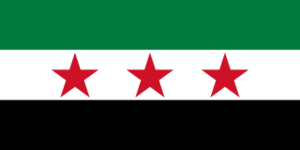
Lebanese paper As-Safir reports that starting on February 5 and during "a fragile truce", negotiations led by prominent opposition figure Michel Kilo took place between the KSC and a certain Revolutionary Military Council in Hasaka province, claiming affiliation with the FSA and SNC. Centering on the events in Ras Al-Ayn, the content of those negotiations seems to include the control over the entire region, according to the paper. The latter party demands as prerequisite for a permanent ceasefire not only the control of the city to be handed over to them, but also all functions of control in Hasaka region including the border crossings, checkpoints and the exclusive raising of the FSA/Freedom/French Colonial flag on squares and streets. The Kurdish flags and fighters would have to disappear, although they promise that "all parties" would have a share in a to-be-founded new council. As the article, published February 7, unsurprisingly reports, negotiations under those conditions failed to reach a settlement.[68]
In a telephone interview Rudaw did with the tribe leader Nawaf al-Bashir on February 6, he praised Turkey for "supporting us militarily, morally, and humanely" and admits that his tribal militia FAEL is among those attacking the town, although he claims that the aggression originates from the Kurdish side whom he again accuses of being proxy forces for Assad and "only fighting the FSA". Yet official spokespeople of the FSA (the article cites deputy leader Malik al-Kurdi) continue to deny that the groups fighting in Ras Al-Ayn, including al-Bashir's, have direct ties with the FSA. Al-Bashir, perhaps revealing his motives in closing:
- We will not allow the separatists to control this province because it is the richest part of Syria in terms of oil and agriculture.[69]
In a rather bizarre article dancing around the topic published the same day, the New York Times manages to basically frame Turkish involvement in and backing of the attacks as conspiracy theories of ultra-nationalistic ideologues.[70]
In an English-language interview with Kurdish Ronahi TV on February 9, PYD leader Salih Muslim confirms that with ongoing negotiations the clashes in Ras Al-Ayn have stopped.[71] In a field report published the same day on a new English-language PYD website, the negotiations led by Michel Kilo are described in a more positive light and the demands less fundamentally opposed than in the Lebanese article summarized above. The report also contains news of dismantling of IEDs left by the armed groups, fixing the electricity grid and deliverance of food and other aid packages by the Kurdish Red Crescent, overall a picture of recovery. The report also contains condemnations of events going on in Al-Ashrafiya district in Aleppo.[72]
February 17: Agreement signed
After several meetings and attempts at reaching an agreement, KSC and FSA finally signed one on February 17. The main points of this agreement are:[73][74]
- all foreign fighters will leave the area;
- there will be joint checkpoints of FSA and YPG;
- there will be a joint local council in the area of Sere Kaniye, based on consensus;
- the local council will take care of the border crossing with Turkey in Sere Kaniye
- it will be easier for local forces, people and goods to move between checkpoints;
- later on, a joint police force will be created;
- FSA and YPG will work together where the area has not yet been liberated from the regime.
By February 25, three quarters of the displaced citizens of Ras Al-Ayn have reportedly returned to their homes.[75]
Five months later
Asia Abdullah, co-chair of the PYD, asked about the role of women in the Kurdish Revolution:
- We are fuelling two simultaneous revolutions: that of our nation and that of women. All of our organizations, social, political military etc, are built up on quotas of 40 percent for women, another 40 percent for men and 20 percent for individuals regardless of their sex. Since the beginning of the revolution we have set up 16 centers to assist women as well as three academies in Afrin, Qamishlo and Kobani (Syrian Kurdish towns) that seek to eliminate the patriarchal mindset ruling society for thousands of years.[76]
After quite exactly five months in which the lines between FSA and Islamist groups further blurred, the fragile agreement in Ras Al-Ayn finally came to an end when on July 16 at 11:30 AM local time an Al Nusra gang attacked a patrolling car of the all-female YPG's Women's Defense Units, taking the driver hostage.[77] The group carried out another attack while negotiating the release of the detained fighter, leading to a fierce counter-attack by the YPG which during the following one-and-a-half days not only freed the detained YPG fighter and chased the Islamist fighters out of the Mehet neighbourhood where they had their headquarter, but this time also brought the border crossing, and thereby all of Ras Al-Ayn, under their control.
This was acknowledged (with "concern") by the Turkish government as reported by Reuters.[78] According to the SOHR, 11 fighters, two of them Kurds, were killed during the clashes.[79] Two Turkish citizens, one of them a 15-year-old boy, were killed by stray bullets from the other side of the border, which according to Reuters led for "the second time in as many days" to return fire from the Turkish military.[78]
During the events, a group of journalists arriving in Ceylanpinar by train were chased away by the Turkish military[80], while someone managed to film at the Ceylanpinar Hospital well-known to readers of this article how this time the treatment of Islamist fighters was accompanied by angry protests of disgusted citizens.
While the Kurds pointed out that the attacks occured exactly a year after the formation of KSC and YPG and the relative autonomy they gained,[76] the Turkish General Staff and Government announced that they would never tolerate an autonomous Syrian Kurd entity and that the taking of Ras Al-Ayn was part of "a bigger plan" in the machinations of a "separatist terrorist organization".[81]
Aftermath
Following these events, attacks on Kurds by Turkey-backed gangs of radical Islamists have been frequent in the whole region and also in Aleppo. On October 5, 2013, the YPG published statistics saying that since July 16 a total of 945 attackers have been killed while 79 YPG fighters lost their lives.[82]
In November 2014 Newsweek interviewed a man from Iraqi Kurdistan who intended to join the FSA but ended up as a communication officer with ISIS, unable to get out. He describes how he was sent with a convoy from Raqqa through Turkey to the Ceylanpinar border-crossing, where they crossed back into Syria and stayed at an ISIS camp near Serekaniye. He surrendered at first chance to the YPG when they attacked the camp and was released months later. According to him, the trip included several stays at safe houses and was fully coordinated with the Turkish army.
- “I have connected ISIS field captains and commanders from Syria with people in Turkey on innumerable occasions,” said Omer.
- “I rarely heard them speak in Arabic, and that was only when they talked to their own recruiters, otherwise, they mostly spoke in Turkish because the people they talked to were Turkish officials of some sorts because ISIS guys used to be very serious when they talked to them.”[83]
References
- ↑ With Anastasia Popova through the wild Kurdistan, vesti.ru TV report from Al-Qamishli, November 11, 2012, Russian with German dub (English transcript formerly here, deleted due to death threats)
- ↑ Schools in Turkey Once Again Closed Due to Fighting in Syria, "InAntalya" Blog, Daily Kos, January 17, 2013
- ↑ Es gab keinen Kurden-Deal mit dem Regime, Interview with PYD leader Salih Muslim, Frankfurter Rundschau, December 1, 2012 (German)
- ↑ 4.0 4.1 Syrian Kurds deliver letter to UK's Foreign Minister, Firat News Agency, February 2, 2013
- ↑ 5.0 5.1 Sere Kaniye: Gefechte zwischen FSA-Rebellen und der syrischen Armee, diekurden.de, November 8, 2012 (German)
- ↑ Ras Al Ain _ ambulance wounded to Turkey 2012.11.12, uploaded by yilmaz8rabi3, November 12, 2012
- ↑ urs1798 Video collection with German descriptions, Part I, II, III and IV
- ↑ FSA-Rebellen verbieten die kurdische Fahne und hissen die Türkeifahne, diekurden.de, November 10, 2012 (German)
- ↑ A young Christian of the opposition: "Minorities crushed in the conflict", Agenzia Fides, Nov 30, 2012
- ↑ Sere Kaniye bombardiert: 6 Kurden getötet, diekurden.de, November 12, 2012 (German)
- ↑ Sere Kaniye: 8 Tote, 57 Verletzte, diekurden.de, November 12, 2012 (German)
- ↑ Sere Kaniye: Kampfflugzeuge bombardieren auch Dörfer, diekurden.de, November 14, 2012 (German)
- ↑ Türkischer Geheimdienst transportiert 600 FSA-Kämpfer nach Sere Kaniye, diekurden.de, November 14, 2012 (German)
- ↑ 14.0 14.1 Ras Al Ain: Kurdistan against the FSA, vesti.ru TV report from Ras Al-Ayn, November 16, 2012, Russian with German dub (English transcript formerly here, deleted due to death threats]
- ↑ Hoher Kurdischer Rat besucht Sere Kaniye, diekurden.de, November 15, 2012 (German)
- ↑ Clashes in Serêkaniyê in West Kurdistan - FLASH, Firat News Agency, November 19, 2012
- ↑ FSA Terrorists Go from Home to Home Killing Civilians that Do Not Cheerfully Embrace Them (18+), uploaded by Eretz Zen, November 14, 2012 (Note: while this is clearly a pro-Assad video, the point made about the usage of term "Shabiha" in a region which in Syria hardly couldn't be further away from the home area of the alleged Alawite militia is valid.)
- ↑ Inside a Syrian border town, uploaded by CNN, November 16, 2012
- ↑ Ras al-Ayn, Al-Hasakah, "FSA Farouq Brigade captures a Syrian Army checkpoint.", uploaded by Curse Thee, November 15, 2012
- ↑ Sere Kaniye: Bewaffnete Gruppen töten Volksrat-Vorsitzenden, diekurden.de, November 19, 2012 (German)
- ↑ 21.0 21.1 Pressemitteilung: Türkei interveniert in Nordsyrien (Westkurdistan), diekurden.de, November 20, 2012 (German)
- ↑ Erklärung der YPG: 18 Kämpfer getötet, 7 festgenommen, diekurden.de, November 20, 2012 (German)
- ↑ Syrian Rebel Commanders Killed in Clashes with Kurdish Fighters, Rudaw, November 20, 2012
- ↑ 24.0 24.1 SNC Leader Abdulbasit Sieda: Kurds Have to Pick a Side In the Revolution Rudaw, published November 22, 2012
- ↑ Syrian opposition clashes with Kurdish militias on border with Turkey, Today's Zaman, November 20, 2012
- ↑ Nach Konfrontation von Kurden und syrischen Fundamentalisten: Tausende begleiten Beerdigung kurdischer Kämpfer, diekurden.de, November 21, 2012 (German)
- ↑ Bewaffnete Banden greifen mit Panzern an – YPG verteidigt Sere Kaniye, diekurden.de, November 21, 2012 (German)
- ↑ New clashes erupted in Serêkaniyê, Firat News Agency, November 22, 2012
- ↑ Sheikh Almqrye Abdel Tawab in Ras al-Ain, uploaded by شبكة أخبار رأس العين العربية, November 22, 2012
- ↑ YPG: Wir werden Sere Kaniye von den bewaffneten Banden säubern, diekurden.de, November 22, 2012 (German)
- ↑ KCK: Paramilitary forces supported by AKP, Firat News Agency, November 22, 2012
- ↑ Bewaffnete Gruppen in Sere Kaniye von YPG zurückgedrängt, diekurden.de, November 23, 2012 (German)
- ↑ Zweitägige Waffenruhe in Sere Kaniye, diekurden.de, November 23, 2012 (German)
- ↑ Sere Kaniye: Erste Angriffsgruppen wollen Waffenruhe, Brigade al Tawhid und Cebel al Zewye greifen an, diekurden.de, November 24, 2012 (German)
- ↑ Sere Kaniye: Gespräche dauern an, einige Gruppen rücken ab, diekurden.de, November 24, 2012 (German)
- ↑ Kürkçü: Government allowing paramilitaries to cross into Syria, Firat New Agency, November 24, 2012
- ↑ Bewaffnete Gruppen geben Sere Kaniye auf, diekurden.de, November 25, 2012 (German)
- ↑ Turkey scrambles fighter jets as Syria bombs city of Ras Ayn, LA Times, December 3, 2012
- ↑ Quellen der YPG: 70 Bandenkämpfer in Sere Kaniye getötet, diekurden.de, January 17, 2013 (German)
- ↑ Syria: Clashes pit Kurds against jihadists, AFP, January 18, 2013
- ↑ Sere Kaniye: Arabische Jugendliche kämpfen auf der Seite der YPG, diekurden.de, January 18, 2013 (German)
- ↑ Kurdish Forces Clash with Main Syrian Opposition in Syria, Reports Say, Rudaw, January 17, 2013
- ↑ 43.0 43.1 Syria's Kurds urge opposition to stop Islamist attack, AFP, January 20, 2013
- ↑ 44.0 44.1 Immer härtere Auseinandersetzungen in Sere Kaniye, diekurden.de, January 20, 2013 (German)
- ↑ Al-Assad in his last six months, US estimates Tolga Tanış, Hurriyet Daily News, January 17, 2013
- ↑ National Coordination Body condemns attacks on Serêkaniyê, Firat News Agency, January 21, 2013
- ↑ العقيد مالك الكردي ليكيتي ميديا : لسنا طرفاً في حرب سري كانيه, Yekiti Media (Arabic), January 19, 2013
- ↑ Civilians and children of Ras al-Ein killed by mortar attacks and snipers, Syrian Observatory for Human Rights, January 21, 2013
- ↑ Schools in Turkish border town close over security concerns, Today's Zaman, January 22, 2013
- ↑ Westkurdistan: Serêkaniyê fast unter Kontrolle der YPG, diekurden.de, January 23, 2013 (German)
- ↑ Serêkaniyê: Kämpfe verschärfen sich – Erste Stadtteile unter Kontrolle der YPG!, diekurden.de, January 25, 2013 (German)
- ↑ 52.0 52.1 52.2 Kämpfe in Sere Kaniye werden intensiver: 20 Banden-Mitglieder getötet, diekurden.de, January 26, 2013 (German)
- ↑ Three members of same family died in Serêkaniyê, Firat News Agency, January 27, 2013
- ↑ Child wounded in Ceylanpınar, Firat News Agency, January 26, 2013
- ↑ Turkish girl hit by stray Syrian bullet, Reuters, uploaded by TalentTOP, January 27, 2013
- ↑ Suriye Kürde Kefen Bicenlerin Sonu, raw footage of activity in front of Ceylanpınar hospital, uploaded by KurdishPower, January 26, 2013
- ↑ @Avend93, twitter message, January 26, 2013
- ↑ Eskalation des Krieges: Arabische Banden zielen auf kurdische Zivilisten, diekurden.de, January 27, 2013 (German)
- ↑ The conflict in Serêkaniyê coordinated from Ceylanpınar, Firat News Agency, January 28, 2013
- ↑ Another night of clashes in Serêkaniyê, Firat News Agency, January 29, 2013
- ↑ @pydinfo, twitter message, January 29, 2013
- ↑ An unnecessary fight against Kurds betrays Syrian struggle, Hassan Hassan, The National (Abu Dhabi), January 29, 2013
- ↑ Sere Kaniye: YPG befreit assyrische Kirche von bewaffneten Banden, diekurden.de, January 30, 2013 (German)
- ↑ YPG seizes French ambulance in Serêkaniyê, Firat News Agency, January 30, 2013
- ↑ @Avend93, twitter message, January 30, 2013
- ↑ YPG veröffentlicht Bilanz der Kämpfe in Serê Kaniyê, diekurden.de, February 1, 2013 (German)
- ↑ 67.0 67.1 Gefangengenommener Al Faruk-Kämpfer: Die Türkei unterstützt uns, diekurden.de, January 31, 2013 (German)
- ↑ Negotiations Fail Between Kurds And Syrian Opposition, Ziad Haidar, As-Safir, translated by Al-Monitor, February 7, 2013
- ↑ Islamists Fighting Kurds in Syria Admit to Turkish Military Support, Rudaw, February 6, 2013
- ↑ Syria's Kurds Try to Balance Security and Alliances, New York Times, February 6, 2013
- ↑ PYD Salih Muslim evaluated the current situation in Syria-West Kurdistan, Ronahi TV, published February 9, 2013
- ↑ On the Ground Activities in West Kurdistan, PYDinfo.com, published February 9, 2013
- ↑ Serêkaniyê: YPG und FSA unterzeichnen Friedensabkommen, diekurden.de, February 17, 2013 (German)
- ↑ Agreement in Serêkaniyê, Firat News Agency, February 18, 2013
- ↑ Ras Al-'Ain Residents Returning To Their Homes, Real Syria Updates, February 25, 2013
- ↑ 76.0 76.1 Syria is controlled chaos, Interview with PYD co-chairs Asia Abdullah and Salih Muslim, Deutsche Welle, August 6, 2013
- ↑ Al Nusra attacks YPG's women fighters in Serekaniye, Firat News Agency, July 16, 2013
- ↑ 78.0 78.1 Kurds seize town on Syria-Turkey border, Ankara concerned,Reuters, July 18, 2013
- ↑ Kurds drive Al-Qaeda fighters out of Ras al-Ain, Daily Star Lebanon, July 18, 2013
- ↑ Turkey's Syrian border closed for journalists, Firat News Agency, July 18, 2013
- ↑ Turkish gov't says won't tolerate PYD's fait accompli in northern Syria, Today's Zaman, July 18, 2013
- ↑ YPG veröffentlicht Bilanz der schweren Kämpfe in Westkurdistan, diekurden.de, October 5, 2013 (German)
- ↑ ‘ISIS Sees Turkey as Its Ally': Former Islamic State Member Reveals Turkish Army Cooperation, Newsweek, November 7, 2014
